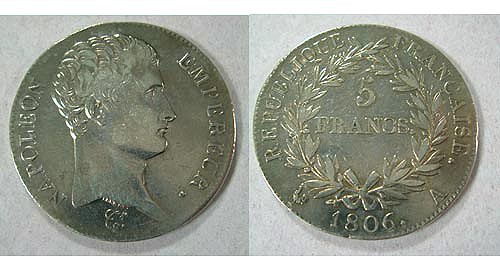On 5 December, 1360, king Jean II le Bon signed an ordonnance creating a new gold currency, the Franc, equal in value to one Livre Tournois. At the time, the term “franc” meant ‘autonomous’. The first Franc in the monetary history of France in fact evoked the recent return to liberty of the French king after four years of captivity in England after the defeat at Poitiers in 1356. The “franc à cheval” (the horseback franc), thus called because it was minted with an image of the king armed and helmeted stamped upon it, made it possible for the king to pay his ransom. Whilst new Francs were issued during the reigns of Charles V and then Henri III, the term itself, synonymous with ‘livre’ (Pound) fell into disuse.
It was with the Revolution that the France became the legal monetary unit in France. On 28 Thermidor, An III – 15 August, 1795, a law decreed that old triumvirate of ‘livre-sou-denier’ (like the old British L.S.D. or librae, solidi, denarii or pounds, shillings and pence – indeed the sign £, which resembles and L in shape, is simply an old scribal abbreviation for Librae) should be replaced by the decimal system. The Franc was divided up into 10 ‘décimes’ each worth 10 centimes. The first decimal Franc coin was a five franc piece, known as “à l’Hercule” (a Hercules five Franc). The figures stamped on the coin are Liberty and Equality surrounding Hercules, the embodiement of strength and union.
But it was not until the Consulate that the first 1 Franc coins were issued, the famous Franc Germinal. “Five grammes of silver, 9/10 pure, constitute the monetary unit named Franc”; such was the description as it appeared in the new law defining the franc. Adopted by Bonaparte on 28 March, 1803 and promulgated on 7 April of the same year (that is, 7 Germinal, An XI, hence the name Franc Germinal), this law fixed the weight and value for commercial transactions. In order to mint the new coinage, machines were required. And so, twenty of the cannon taken at Austerlitz were used to make the screw press still in use at the Monnaie de Paris and called the ‘Balancier d’Austerlitz’.
The first 1 Franc piece bore the figure of the First Consul on the obverse or ‘heads’ side and the legend ‘République française’, the year and the value of the coin surrounded by a laurel crown on the reverse or ‘tails’ side. Half, quarter Francs, as well as 2 and 5 Franc pieces were minted using the same metal. 20 and 40 Franc pieces were made of gold. The Franc eloquently reveals the political development of the regime. After the proclamation of Empire, a profile of the Emperor replaced that of the First Consul, but the reverse side still bore the words “République française”! It was not until after 1808 that the legend was changed to read “Empire français”.
Karine Huguenaud (tr. P.H.)
January 2002


